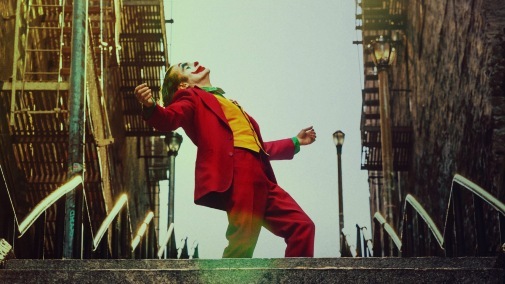The Look of "Joker"
 Wednesday, October 16, 2019 at 9:00PM
Wednesday, October 16, 2019 at 9:00PM by Cláudio Alves

In 1989, Tim Burton envisioned Gotham City as an Expressionistic nightmare, something necessarily unreal. Three years later, Batman Returns showed a different sort of urban reverie, one tainted by quasi fascistic imagery, an appropriate dark meaning for a darker film than its predecessor. Joel Schumacher's sequels would see Gotham go through another transfiguration, from a gloomy nightmare into a candy-colored hallucination. This process of growing artificiality would end when Christopher Nolan revitalized Batman for a 21st-century audience.
Nolan's trilogy shows us a Gotham that's a foreigner's idea of an American metropolis and one can almost chart, throughout the films, how the city goes from being a dream of Chicago to New York City 2.0. Todd Phillips' Joker perpetuates this configuration of Gotham as DC Comics' version of Manhattan, but he isn't looking to the real contemporary city for inspiration. The film is set in a New York of yore, a fantasy built from nostalgia and the cinematic legacy of New Hollywood's urban dramas. Gotham is never just a city, rather the idea of one…

Mark Friedberg is used to look at New York City as something to be dreamed up rather than faithfully recreated. In Charlie Kaufman's Synecdoche New York, the production designer built an absurdist city of overt theatricality mixed with tactile immersion. Todd Haynes' Wonderstruck had him seeing the city through the eyes of children. Last year, for Barry Jenkins' If Beale Street Could Talk, he turned New York into an evocation of feeling and color, a city born out of a lover's heart instead of the head of urban planners.
Joker's Gotham is a pre-Giuliani New York born out of the pits of darkness in its protagonist's psyche. It's also born out of Martin Scorsese's filmography with a bit of Lumet and Death Wish mixed in. Both Phillips and Friedberg have been open about how they borrowed Joker's aesthetic from those films, effectively choosing to use other directors' cinematic language as shorthand for the gritty portrait of a dangerous man. There's no need to build a multidimensional coherent character when you can just echo characterizations from the past and let the audience do the rest of the work.
 While Joker wasn't to my liking, many of its elements managed to impress. The whole isn't as good as its parts, one might say. Friedberg's work is genius, borrowing from the past, while molding its imagery into something new, echoing the late 70s without copying them. The tactile materiality of Scorsese's New York is absent, for instance, leaving instead the horror of oppressive spaces, weird color combinations, old apartments. and dirty lockers. Whenever we see something visually cleaner, it's wrong and distressing, like off-white hospital walls or the guilded spectacle of a gaudy bathroom.
While Joker wasn't to my liking, many of its elements managed to impress. The whole isn't as good as its parts, one might say. Friedberg's work is genius, borrowing from the past, while molding its imagery into something new, echoing the late 70s without copying them. The tactile materiality of Scorsese's New York is absent, for instance, leaving instead the horror of oppressive spaces, weird color combinations, old apartments. and dirty lockers. Whenever we see something visually cleaner, it's wrong and distressing, like off-white hospital walls or the guilded spectacle of a gaudy bathroom.
Mark Bridges' costumes avoid the Joker's iconic palette, opting for rust tonalities and faded gold, but the purples, oranges, and greens of the comics do make an appearance. Friedberg peppers them through his sets, haunting this new Joker with the chromatic ghosts of past incarnations. Lawrence Sher's splendorous cinematography also helps in these games of color and tone, painting Gotham as a toxic thing, lurid and poisonous. If past Gothams were hellish cities in need of a hero, this one is far beyond the possibility of salvation. It's rotten to the core and smells of decay.
It's Taxi Driver viewed through a prism of contemporary nihilism and comic iconography. It's not complex or very risky, as some have said, but it's far more interesting looking than the majority of comic book adaptations. It's easy to see how many are being seduced by its diet version of New Hollywood nostalgia. Its craft excellence might not be used to create a film that rises above controversial mediocrity, but it is excellent nonetheless and it wouldn't be surprising if some Oscar nominations were to follow. Even if the idea of Academy Award-winning Joker is a bit distressing, I wouldn't mind seeing Mark Friedberg holding a little golden man.




Reader Comments (4)
The filmmakers really nailed the aesthetic, which goes hand-in-hand with the noxious urban milieu. Really striking work.
i'm looking forward to seeing the film. the trailers hooked me in. i know the reviews haven't been great, but the cinematography and production design have reeled me in. i also think Joaquin Phoenix is one of our most underrated actors.
I loved it. Saw it three times and I want to see it again. And look, I'm not a comic book movie buff. Those who wait to see this movie on TV will regret it because it's the kind of movie made to be seen on the big screen. When I am told that the movie is garbage I answer "may be, but it's beautiful to the eyes."
Oh, and I don't think I need to - but I will - mention Joaquin Phoenix's work. As expected and required, nothing short of extraordinary.